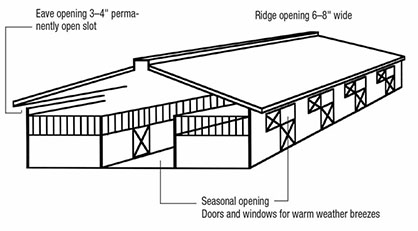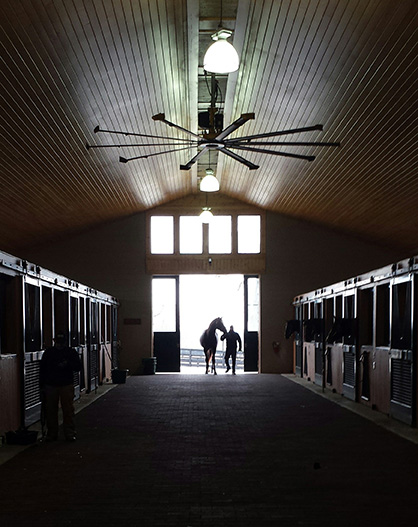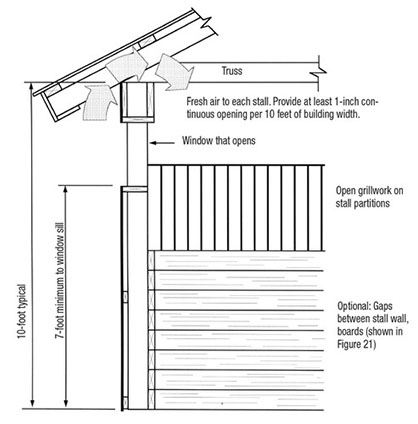The HUGE Problem With Your Barn That You May Have Missed…
By: Brittany Bevis
Gloves, scarf, and hat pulled on tight, you step outdoors into brisk, 28 degree weather with a blustery, northwest wind and wind chill in the single digits. Thankfully, the second you slide open your barn door, you’re enveloped by a warm hug of hot air, equivalent to that of a life size, equine convection oven. Sound great? To you, maybe, but to your horses, not so much.
“Inadequate ventilation is the most common mistake made in modern horse facilities”- (Penn State College of Agricultural Sciences, 2016)
According to Horse Stable Ventilation, prepared by Eileen Fabian Wheeler, Associate Professor of Agricultural and Biological Engineering at Penn State, the most comfortable temperature range for horses is 45-75°F. But, some horses with long hair coats can easily withstand 0°F. Show horses with sleek hair coats can be maintained indoors, while wearing blankets, in a cold, but dry, stable. According to the study’s recommendation, during winter, horse stables should be kept no more than 5 to 10°F warmer than outside temperatures.
So, you’re thinking… “I live in Wisconsin; there’s no way that’s practical!” Here’s what they have to say about that. “This guideline helps assure fresh air conditions, but it also means freezing will occur inside stables in northern climates. It’s a management mistake, with regards to air quality and to your horses’ health, to close the barn tight just to keep conditions above freezing in cold weather. If condensation occurs on interior surfaces, then the stable is too closed off for proper ventilation,” (Penn State, 2016).
Here are two terms that are helpful to understand when talking about stable ventilation.
#1- Air Exchange- When stale air is replaced with fresh air.
#2- Air Distribution- How fresh air moves and is made available throughout the stable.
Note: Having one without the other means your stable has inadequate ventilation.

Eave openings, ridge openings, and seasonal openings like doors and windows can improve ventilation within a stable. Penn State Image
You may love the cozy feel of your tightly, closed up barn, but if the stench of ammonia is overwhelming, that’s an indication your stable has poor air quality due to limited air exchange. To best determine the air quality in your barn, check out the environment in one of the stalls, where most of the moisture and odor are generated. If the smell is too much for your lungs to handle, think what it’s like for a foal that spends most of its time at ground level…
Proper ventilation is not only important in the summer to remove excess heat from the barn; it’s even more important in the winter to control odor, ammonia, and moisture, which builds up as a result of horse respiration, bathing, and stable cleaning. Too much moisture buildup can lead to “increased risk of condensation, intense odor, more ammonia release, pathogen viability, and contribute to respiratory infection,” (Penn State, 2016).
What’s Natural Ventilation?
If we’re getting technical, natural ventilation is referred to as “air changes per hour,” which means that the total volume of air in the stable is replaced in an hour’s time. According to the study, a good rule of thumb is to have 4 to 8 air changes per hour.
How do you provide natural ventilation? This can be accomplished via openings along the sidewall and ridge, or “roof peak,” or by way of mechanical ventilation like fans. Worried about openings creating a drafty barn? There are many options, like a continuous slot opening at the eave or a breathable wall.
Continuous Slot Opening
The ideal location for a slot opening is at the top of each stall, 10-12 feet above the floor, where the sidewall meets the roof. According to the study, a good guideline is to have at least 1 inch of continuous-slot, permanent opening for each 10 feet of building width. Because the opening is located 10-12 feet above the floor, the incoming, cold air is mixed with warmer air before it reaches the horse. The small opening allows for good air exchange but prevents big gusts of cold air that an open window or door would provide.
Breathable Wall
Another interesting concept is a breathable wall, which is accomplished with barn board siding. The many small cracks between the boards allow for air movement, but prevent large gusts of wind from entering the barn.
Want to improve the ventilation within your barn, but not ready for a full redesign just yet? Here are a few ideas.
- Install open grillwork on the top and side partitions of the stalls to increase airflow.
- Don’t put hay or bedding in any overhead storage that’s located above the stalls.
- Consider using a fan; however, keep in mind that this won’t improve air quality, only air movement.
For more information about stable ventilation, click here: http://create.extension.org/sites/default/files/w/e/ea/stable_ventilation.pdf
For more valuable information about Horse Facility Design and Construction visit: http://extension.psu.edu/animals/equine/horse-facilities
This page is chock full of great information about manure management, fire protection systems, stall design, fence planning, flooring materials, drainage, temperatures for indoor riding arenas during cold weather, and footing materials.












